Youth Bat Speed & Exit Velocity Drills 2025: Proven Power Training Program to Fix Weak Swings & Boost Hitting Power Fast
Learn how to increase hitting power using a bat speed and exit velocity exercises drill formula for baseball, softball, and slow pitch. Discover what is a good ball exit speed off the batting tee by age, and average High School programming. When it comes to ball exit speeds by age, here’s what I like to see by the end of each year, off the tee… (add about 5-mph exit velocity to the following, in game at-bats)
- Seniors: 90 to 95-mph
- Juniors: 85 to 90-mph
- Sophomores: 80 to 85-mph
- Frosh: 75 to 80-mph
- 8th graders: 70 to 75-mph
- 7th graders: 65 to 70-mph
- 12 years old: 60 to 65-mph
How To Hit 120.5-mph Ball Exit Speeds Like Josh Donaldson
Amy Gill and Andrew Marden from KSEE24, a local sports news station here in Fresno, CA, put this video together of an HPL Batted Ball Distance Challenge held about a month ago.
We worked primarily on testing “showing the numbers“, and the results were interesting…
Twelve total hitters, ranging in ages from 8-17 years old. Nine of them had been exposed to the HPL system. Two of them had not, and one had minimal exposure.
The familiar ones (control group) gained or lost between -1 to +1-mph of Ball Exit Speed, while the three “newbies” gained between 3 and 10-mph of Ball Exit Speed in one 30-minute session. That’s between 15 to 50-feet of added batted ball distance!!
SCIENCE-BASED TRAINING:
Improve your hitting strategy dramatically by applying human movement principles.
Learn not only how and what to train but also the science behind the methods.
The Definitive Guide To Measuring, Tracking, & Boosting Ball Exit Speed
On April 23rd, 2015…
The Toronto Blue Jays’ 3rd baseman, Josh Donaldson, hit a two-run homer to left off Chris Tillman that was clocked at 120.5-mph!
And as of August 18th, according to ESPN’s HitTrackerOnline.com (no longer available), was the highest Ball Exit Speed home-run in 2015. By the way, this topped Giancarlo Stanton’s highest Ball Exit Speed homer, in the same year, by 3.2-mph (117.3-mph).
How does Josh Donaldson do it?
I mean, come on!
Giancarlo Stanton, also referred to as “Bigfoot”, stands at a gargantuan 6-foot, 6-inches tall, 240-pounds. And from what I hear, has about 3-4% bodyfat.
On the other hand, Josh Donaldson stands in at mere 6-foot, 220-pounds.
Talk about David & Goliath!
But what little realize about David was that he was an expert marksman from long range. So he never had to go toe-to-toe with Goliath.
David had a better strategy. And so do small sluggers like Josh Donaldson.
In this post, we’ll be talking about Ball Exit Speed (BES), also known as Speed Off the Bat (SOB), or simply Exit Speed. We’ll learn:
- What affects Ball Exit Speeds?
- What is the Desirable Minimum Effective Dosage (MED) for Ball Exit Speed? And
- How-to increase Ball Exit Speed…
What Affects Ball Exit Speeds?
“What gets measured gets managed.” – Peter Drucker
Recently, I use a Pocket Radar Ball Coach to measure the Ball Exit Speeds of my hitters, off the tee, before and after each session.
It’s not radar gun accuracy we’re looking for here, but an apples to apples comparison. Here’s what we’re comparing, using the radar gun, before and after each hitting session:
- Did the hitter beat a personal record (PR), and/or
- How consistent and stable their Ball Exit Speed readings are, or whether they’re jumping all over the place.
Unlike bat speed, there are many things that can affect the speed of the ball coming off the bat:
- Bat Composition (BESR rating) – Wood v. non-wood. End loaded v. more balanced weight. Bat size and weight.
- Ball Composition (COR rating) – Plastic balls v. rawhide. Corked core v. rubber. Higher v. lower seams.
- Hitter’s Arm/Leg Length vs Body Mass – In my opinion I think limb length is more of a factor than body mass. And Physicist Dr. Alan Nathan has confirmed this.
- Ball Spin Rate – Backspin and topspin, in addition to the coveted knuckle-ball will all affect BES differently.
- Effective Mechanics – the better a hitter is at effectively using human movement rules that are validated by science, the better energy transfer from body to barrel to ball.
- Pitching Velocity – From what I’ve heard and seen, pitch speed can add between 10-20-mph to Ball Exit Speeds, say from off the tee.
- Fatigue – sleep, over-training, nutrition, and supplementation. CLICK HERE for Zach Calhoon’s recovery shake mix.
- Warm Up Factor – I noticed in my latest Zepp swing experiment, that I didn’t consistently hit 90+mph Ball Exit Speed, off the tee, until I reached about the 75 swing mark.
- Learning New Hitting Mechanics – I’ve noticed with my hitters that when we introduce a brand new hitting movement into their swing, their Ball Exit Speeds drop between one to four-mph. But if it’s something we’ve covered before, then they may actually increase by one to four-mph.
- Timing – If a hitter is too late, and doesn’t allow his or her bat speed to mature, then Ball Exit Speeds will be lower. If a hitter is too early, and their bat speed has begun to decelerate, then Ball Exit Speeds will also go down.
- Environment – Humidity dampens Ball Exit Speeds (pun intended). So does a head wind, duh. On the other hand, hitting in dry hotter climates OR in Denver, Colorado, Ball Exit Speeds will increase because the air is less dense.
- Hitting the Sweet Spot – Hitting the ball on the end of the bat, or closer to the hands will decrease Ball Exit Speed, while consistently hitting the sweet spot will boost it.
- Bat Speed at Impact – Most of the time Ball Exit Speeds will be higher than Bat Speed at Impact. With my Zepp swing experiments off the tee, it looks to be about a 6-mph difference.
- Strength and conditioning – this can help but shouldn’t be the highest priority. This should be the cherry on top.
- Mobility and stability – if you move better, then you perform better. Simple as that. This MUST be a high priority not just to increase BES, but to minimize an athlete’s risk for injury.
What is the Desirable Minimum Effective Dosage (MED) for Ball Exit Speed?
“The smallest dose that will produce the desired outcome.” – Tim Ferriss on MED, 3-time NY Times Bestselling Author
According to this Wall Street Journal article titled, Yankees Dive Into the Numbers to Find Winning Patterns,
“Computers can track a ball’s exit velocity, launch angle, hang time and spin rate, 100 mph, the
speed necessary for most home runs; 75 mph, commonly the break-even pace for a ground ball to skip through the infield for a hit; and four seconds, the inflection point for fly ball hang-time, with any remaining in the air that long before getting caught.”
You may be wondering, what is the launch angle for a typical home-run? According to the following Sports Science video, about 20-degrees:
According to a Beyond the Boxscore article titled, Do Hard Hit Ground-balls Produce More Errors?, that there is no significant increase in errors, at the Major League level, until Ball Exit Speeds reach and go beyond 95-mph.
This NY Times article titled, New Way To Judge Hitters? It’s Rocket Science – Sort Of, reports about Ball Exit Speed that:
- The threshold for hitting a homerun is 95-mph,
- Ball Exit Speed is being used to evaluate upcoming professionals, and can decide who starts,
- Managers can use Ball Exit Speeds to see if there’s a drop off in a hitter’s Ball Exit Speed, which may reveal the player is hurt or needs to adjust their mechanics, and
- Teams can shift their infielders back with hitters clocking higher Ball Exit Speeds.
And lastly, an article from eFastball.com titled, Bat Speed, Batted Ball Speed (Exit Speed) in MPH by Age Group, had this to say:
“MLB average exit speed is 103 mph, bat speed ranges roughly from 70-85 mph. 1 mph of additional exit speed makes the ball go 5 more feet. This would be roughly 4 feet for 1-mph bat speed – which is less than the 7-8 feet we have heard from other studies.”
Based on the information above, ideally the MED Ball Exit Speed, for the average Little Leaguer, would be 40-mph BES (40-mph BES X 5-feet = 200-feet of distance). I want my Little Leaguers to get to 50-mph BES, for the fields that have 220-foot fences. And of course launch angle is a huge factor in this.
And on the big field, it looks like 95-mph Ball Exit Speed is the MED because that means the hitter has the ability to hit the ball 475-feet (95-mph BES X 5-feet of distance). Furthermore, the fact that Beyond the Boxscore’s observations about errors not increasing until Ball Exit Speeds reach 95-mph.
How-to Increase Ball Exit Speed
“Whenever you find yourself on the side of the majority, it is time to pause and reflect.” – Mark Twain
So, what advantage does a small slugger like Josh Donaldson have over Giancarlo “Bigfoot” Stanton?
Here’s the secret to boosting Ball Exit Speeds…
Tinker and Test.
Remember, Peter Drucker’s quote above?
“What gets measured gets managed.”
Here’s what to do to ensure a healthy increase in Ball Exit Speeds:
- Get yourself a Bushnell Radar Gun
and/or a Zepp baseball app,
- CLICK HERE to read the definitive guide to running swing experiments,
- Choose an HPL “Topic” in the navigation bar above, or search for one in the upper right hand corner of the website, and start testing.
- Stop analyzing big hitters. Instead look at the small sluggers, and see what they’re doing to compete, such as: Cano, McCutchen, Donaldson, Bautista, Vogt, Beltre, Braun, Pedroia (averages 44 doubles and 15 homers a season), Victor Martinez, Edwin Encarnacion, David Wright, Hank Aaron, Sadaharu Oh, and Mickey Mantle.
Do you have anything to add to the discussion? Please REPLY below…
- Fix Late Swings Fast: 2025 Pitch Recognition & See-Decide-Swing Training for Youth Baseball Power Hitters - October 6, 2025
- Safe Youth Weighted Bat Training: Proven Overload/Underload Drills to Increase Exit Velocity in Games Starting Tonight - September 29, 2025
- AI Coaching Course 2025: Youth Baseball & Softball Practice Plan + Off-Season & In-Season Workout Builder Fast - September 23, 2025


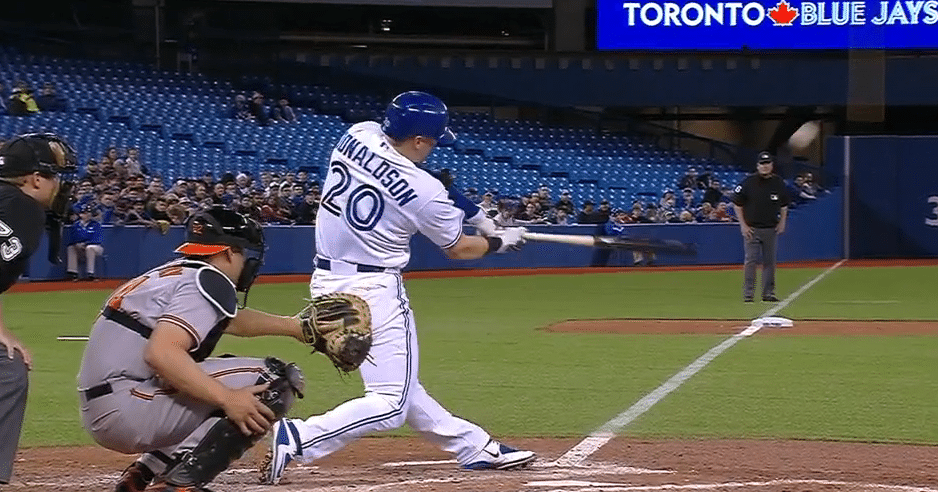

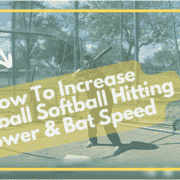
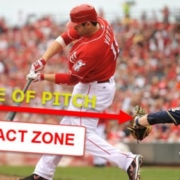
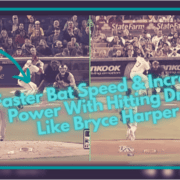

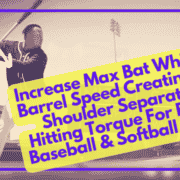
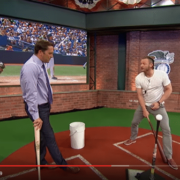




To me … ball exit speed and ball trajectory are the two biggies in hitting. You can have great bat speed and no power, or hit choppy grounders. Ball exit speed means you squared it up – and if a player is concerned with exit speed, it’s assumed he wants to hit it far … for extra bases etc. So exit trajectory is paramount as well.
I totally agree Bob. Glad you guys are enjoying the presence of Josh Donaldson over there in Toronto 😉
He’s a keeper.
Based on the information above, ideally the MED Ball Exit Speed, for the average Little Leaguer, would be 40-mph BES (40-mph BES X 5-feet = 200-feet of distance). I want my Little Leaguers to get to 50-mph BES, for the fields that have 220-foot fences. And of course launch angle is a huge factor in this.
I have a 52lb 8 yo girls that hits consistantly 46 mph exit speed off a T. If the above statement is true she should be able to hit 200 ft but even when she squares up a 40mph pitch from me the absolute best she has ever done is 155ft. That was what looked to me to be a great launch angle. She is hitting an 11 inch softball so i assume that will adjust the numbers some but not by 45 ft. So what is the issue do you think? Assuming form is correct.
Stan, good question. I’m conservative with the Ball Exit Speed MED, I say 4-feet of distance. This comes from a guy who’s worked for PocketRadar for over 15 years. Adding 4-feet of distance for every 1-mph of BES seems to be more realistic. So I tell my Little Leaguers and my girls that if they can hit a 50-mph BES, then they have the capability of hitting it 200-feet. Remember, the softball is much heavier and bigger than a baseball, so BES in softball will be much lower.
So I have my son with a guy in Memphis…Wow Factor Baseball…Evan Eindhardt. We have been doing something similar with him and it is working… Taylor, my son is a HS senior and starting catcher. He has been at it a month and has increased his EV from a 75 to a 82 (off a tee) in only a month of work!!! So based on the above calculations EV 82 x (4+5)/2 = 369 feet…. my question is this. What launch angle is that assuming??? 20-40???? The reason I am asking is that we recently got to hit on a Hittrax system at Arkansas State University and it showed him at a 14-16 degree launch angle. He has rarely popped the ball up..been more of an line drive guy. I also really liked your idea on focusing on smaller hitters and watching how they get the most out of their smaller frames… Taylor is 5’10” 200lbs.
Great job!!! Big gain in a month 😀 About the launch angle, Physicist Dr. Alan Nathan says optimal launch angles would be in the 25-30 degree range. 14-16 is what I call a medium line drive range, which is where the ball lands somewhere in front of the outfielder. High line drive are where you see the outfielder’s numbers. Please keep me updated on his progress.
Is there a difference between tracking velocity from the side of the batter (HitTrax) vs behind or in front with a radar gun?
Good question. I’m not sure. The way to test is while doing HitTrax, have someone holding PocketRadar behind hitter, and compare. I assume HitTrax will be more accurate, so take that into account.